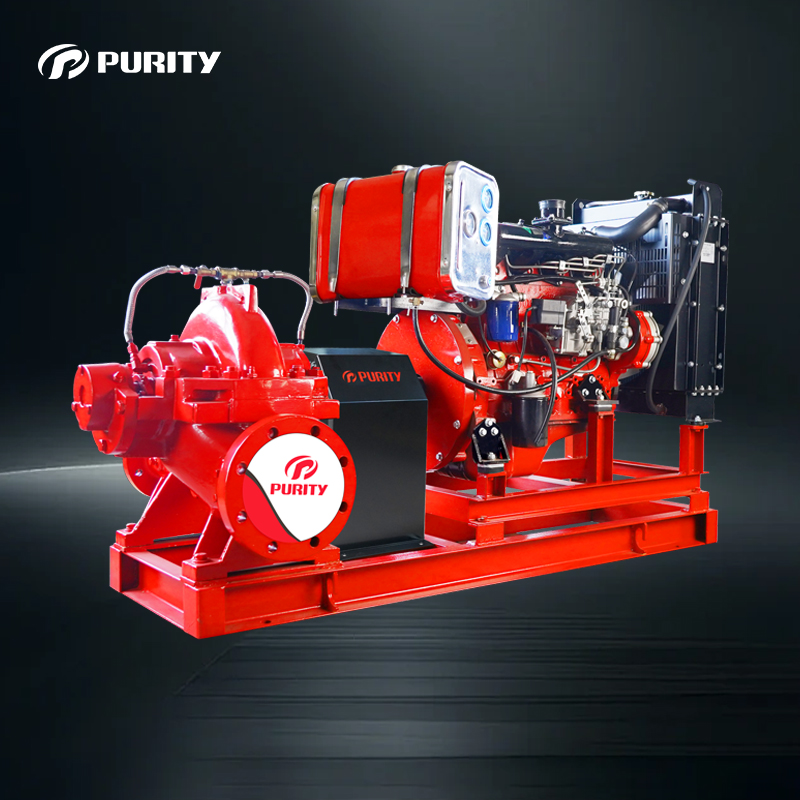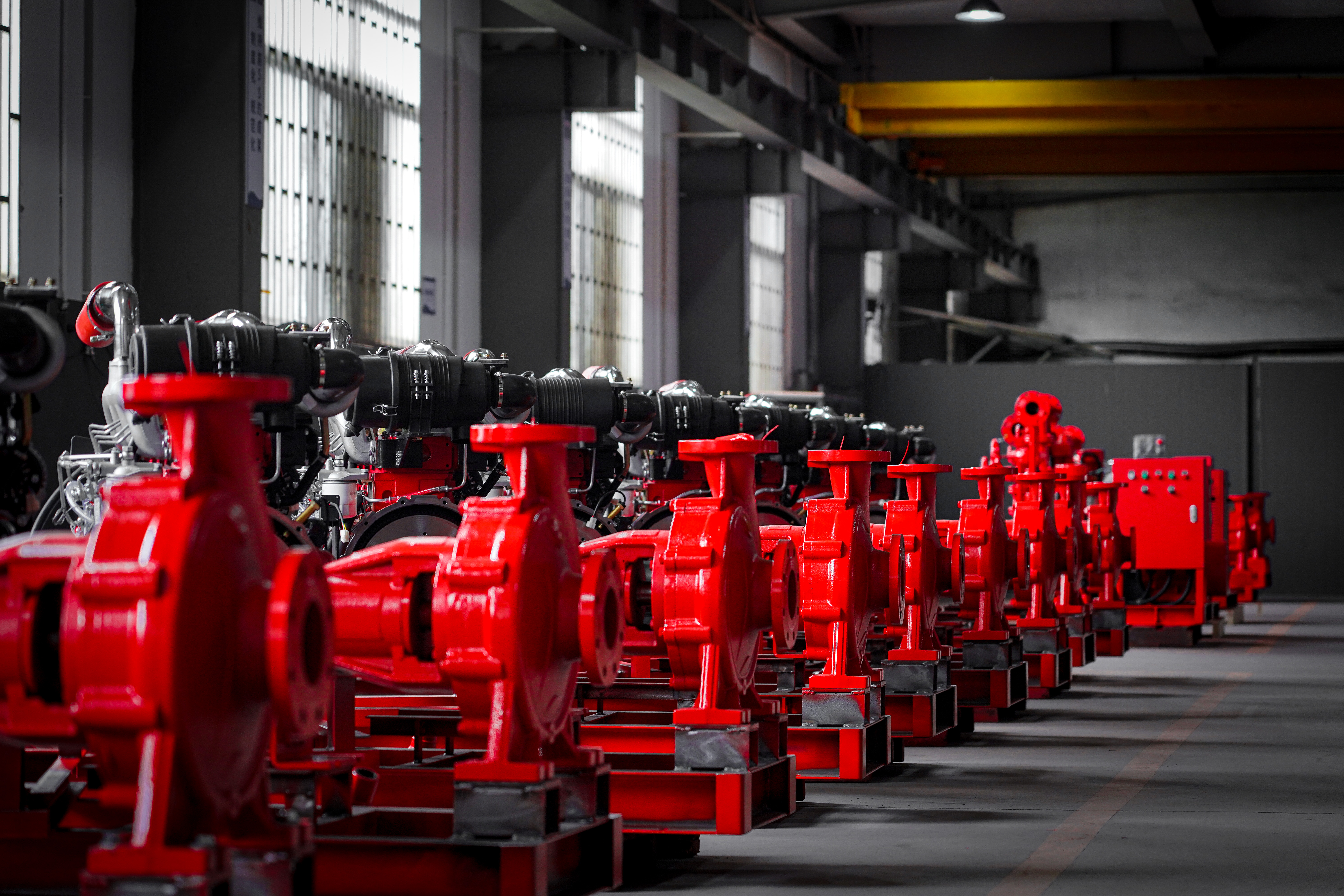A fire pump is the heart of any fire protection system, ensuring that water is delivered with the required pressure during an emergency. But how long can you expect a fire pump to last? The answer varies depending on several factors, including the design, maintenance, and operating conditions of the pump. In this article, we’ll explore the life expectancy of a fire pump, the key maintenance practices, and how to extend the lifespan of your fire pump system.
1. Fire Pump Life Expectancy
A well-maintained fire pump typically lasts between 20 to 30 years. However, its actual lifespan can vary due to several factors:
- Pump Type: Pumps like the double suction fire pump generally have a longer lifespan. The Purity PSCD model, for example, has a mid-open design, making it easy to dismantle and check components without disturbing the alignment of the pump body and inlet/outlet pipes. This design contributes to its longevity.

Figure | Purity special split fire pump PSCD
- Drive Type: Diesel-driven fire pumps may require more frequent overhauls than electric pumps due to the more demanding nature of diesel engines.
- Frequency of Use: A fire pump used only during emergencies will have a longer lifespan than one that operates continuously in high-demand systems.
- Maintenance: Regular servicing can add 5 to 10 years to a fire pump’s life. Neglecting maintenance, on the other hand, can significantly shorten its operational life.
2. Key Factors Affecting Fire Pump Lifespan
Several elements play a critical role in determining the life expectancy of a fire pump. These include:
(1) Proper Installation of the Fire Pump
Correct installation is crucial for maximizing the pump’s life. Ensuring proper alignment of pipes, electrical connections, and calibration prevents premature wear. Improper installation can lead to vibrations, leaks, or motor failure, all of which can drastically reduce the pump’s service life.
(2) Routine Maintenance and Servicing
- Monthly Testing: Even when not in use, it’s essential to test the fire pump monthly to ensure it is in good working condition. A short, regular run will help prevent seals from deteriorating.
- Annual Inspections: Yearly checks should include inspecting bearings, seals, and impellers. Verifying that pressure and flow are up to design specifications is also critical.
- Major Overhaul: Every five years, replace wear-prone parts such as mechanical seals and gaskets to prevent breakdowns.
(3) Fire Pump Supplier Quality
The quality of the components and materials used in the pump significantly influences its longevity. Well-known fire pump suppliers like Purity offer durable pumps made from high-quality materials such as stainless steel or cast iron, which resist corrosion and wear. Additionally, efficient designs, such as the double suction fire pump, are engineered for balanced load distribution, reducing wear and extending the pump’s life.
3. Signs Your Fire Pump Needs Replacement
Regular maintenance will help detect issues early, but certain signs indicate when it might be time to replace your fire pump:
- Pressure/Flow Decrease: A drop in pressure or flow often indicates worn or blocked impellers. This reduces the pump’s ability to deliver the required performance during an emergency.
- Excessive Noise or Vibration: Unusual noise or vibration suggests misalignment of bearings or the pump shaft, which can cause serious damage if not addressed.
- Frequent Repairs: If repair costs exceed 30% of the price of a new pump, it is often more economical to replace the pump than continue maintaining it.
4. Maximizing Fire Pump Life
To ensure your fire pump operates efficiently for as long as possible, here are some additional tips:
- Use a Double Suction Fire Pump: A double suction design provides better balance and minimizes wear on components, which leads to a longer lifespan.
- Install Bypass Lines: Installing a bypass line can reduce running time during testing and decrease wear on the pump.
- Monitor with IoT Sensors: Using Internet of Things (IoT) sensors to monitor temperature, pressure, and vibration can help detect potential issues early, allowing for preventive maintenance before significant damage occurs.
5. Choosing a Reliable Fire Pump Supplier
Selecting a trustworthy fire pump supplier is key to ensuring you get a high-quality fire pump that will last. Look for suppliers who offer:
- NFPA 20/UL/FM Certification: This ensures the fire pump meets international fire safety standards.
- Local Service Support: Opt for suppliers who offer quick repair services and emergency support, ensuring that your system is always ready when you need it most.
- Custom Solutions: Some suppliers, such as Purity, offer customized solutions, including explosion-proof pumps for hazardous environments like oil and gas facilities.

Picture | Actual shot of the Purity factory
6. Conclusion
The life expectancy of a fire pump depends largely on correct installation, regular maintenance, and the quality of the components used. With the right care, a fire pump can provide reliable service for 20 to 30 years. Choosing a reputable fire pump supplier like Purity, investing in a double suction fire pump, and maintaining a proactive maintenance schedule are the best ways to ensure that your fire pump system remains operational for decades.
Whether you’re installing a new fire pump or need urgent fire pump repair, working with a trusted supplier ensures that your fire protection system will provide dependable service when it matters most.
Post time: May-07-2025



